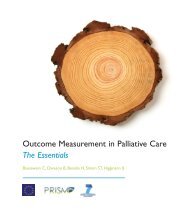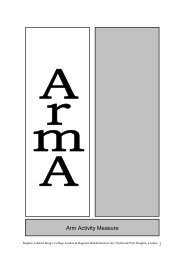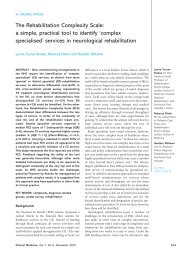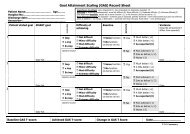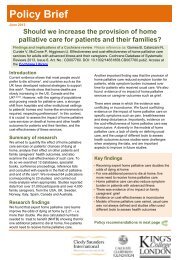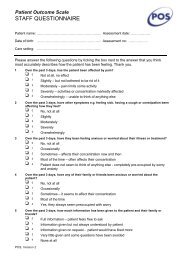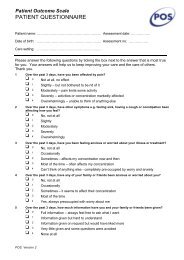Clinical Rehabilitation - King's College London
Clinical Rehabilitation - King's College London
Clinical Rehabilitation - King's College London
You also want an ePaper? Increase the reach of your titles
YUMPU automatically turns print PDFs into web optimized ePapers that Google loves.
Development of Northwick Park Therapy Dependency Assessment 933<br />
50<br />
Total NPTDA score: prospective<br />
40<br />
30<br />
20<br />
10<br />
10<br />
20<br />
30<br />
40<br />
Total NPTDA score: retrospective<br />
50<br />
Figure 3 Scattergram of prospective versus retrospective total Northwick Park Therapy Dependency Assessment scores.<br />
The scattergram demonstrates a reasonably close association between prospectively-rated ‘intended levels of intervention’<br />
with retrospective ratings of ‘actual intervention’. Where intended levels of intervention were higher than those actually<br />
delivered, the differences corresponded to real deviations from intended practice in most instances.<br />
2) Other departures from expected plans<br />
included:<br />
a) unexpected absence of one staff member on<br />
long-term compassionate leave,<br />
b) some documented episodes of intercurrent<br />
illness (for both patients and staff)<br />
c) failure of delivery of specialist equipment<br />
items, requiring discharge planning<br />
arrangements to be altered.<br />
After reviewing the scores for specific instances<br />
of disagreement, the team agreed that, in the<br />
majority of cases, discrepancies between NPTDA<br />
scores had appropriately identified a real deviation<br />
from the level of intervention intended. This<br />
provides some support for the notion that the<br />
tool may have potential future application in<br />
describing the difference between the level of<br />
input provided, and hypothetical situations such<br />
as level of service ‘intended’ (as tested here) or<br />
the level of services ‘needed’ – although this must<br />
be tested separately. In the meantime, it underlines<br />
the importance of specifying the mode of application<br />
when results are reported.<br />
In comparison with the NPDS, on which<br />
the NPTDA is modelled, it is important to recognize<br />
that the estimation of ‘requirements for therapy’<br />
is inevitably more subjective than that<br />
for ‘basic care needs’ which most people would<br />
reasonably regard as essential. Previous experience<br />
suggests that these tools continue to evolve<br />
and develop over a decade or more, and much<br />
wider testing and validation will required<br />
before the NPTDA can be accepted on a similar<br />
footing to the NPDS as an estimation of ‘needs’.<br />
That said, the potential for hypothetical application<br />
makes the NPTDA unique, in comparison<br />
with other existing tools 5,7–12 which can only<br />
be applied to describe interventions that were actually<br />
given. However, these other tools offer the<br />
advantage of more detailed analysis of specific<br />
therapy interventions than is possible with<br />
the broad-brush approach of the NPTDA.<br />
In this respect, the two different approaches<br />
may be found to complement each other and<br />
may usefully be applied in combination in future<br />
attempts to characterize black box of<br />
rehabilitation. 20





